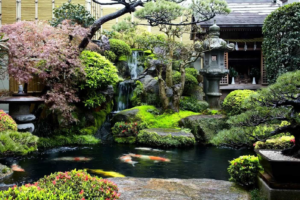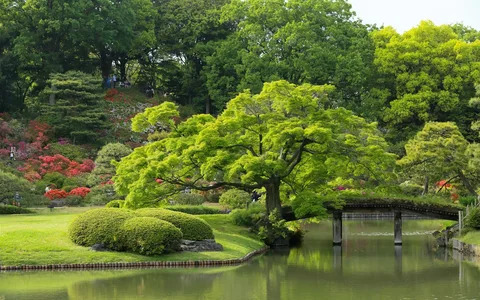Nestled within the serene landscapes of Japanese gardens, amidst meticulously arranged stones, tranquil ponds, and winding pathways, thrive the exquisite treasures known as Japanese Garden Trees. These botanical marvels, meticulously cultivated and pruned to embody harmony and balance, have captivated the hearts and minds of enthusiasts around the world. From their graceful forms and intricate branching patterns to their profound cultural significance, Japanese Garden Trees offer a window into the rich tapestry of Japanese aesthetics and gardening traditions. In this exploration, we delve into the allure of japanese tree garden, tracing their historical roots, unraveling their symbolic meanings, and reflecting on their enduring legacy in both horticulture and culture. Join us on a journey through the enchanting world of japanese tree garden, where beauty, tradition, and tranquility converge in perfect harmony.
Overview of Japanese Garden Trees
Definition and characteristics of Japanese Garden Trees
Japanese Garden Trees, often referred to as “niwaki” or “bonsai,” are meticulously cultivated trees that embody the principles of Japanese aesthetics and garden design. These trees are meticulously pruned and shaped to evoke a sense of harmony, balance, and natural beauty. Characterized by their graceful form, intricate branching patterns, and often compact size, trees for a japanese garden are revered for their elegance and tranquility.
Historical significance in Japanese culture
Japanese Garden Trees have a rich historical significance deeply rooted in Japanese culture. Originating from ancient Japanese gardening traditions, these trees have been cultivated for Deciduous Trees centuries as integral elements of Japanese gardens, where they serve as focal points for meditation, contemplation, and connection with nature. The art of pruning and shaping these trees, known as “niwaki,” has been passed down through generations, reflecting a profound reverence for nature and an aesthetic sensibility unique to Japanese culture.
Types of Japanese Garden Trees commonly used
Several types of trees are commonly used in Japanese garden design, each with its own unique characteristics and symbolic significance. Some of the most popular varieties include:
- Pine Trees (Matsu): Symbolizing longevity, resilience, and steadfastness, pine trees are prized for their evergreen foliage and rugged appearance.
- Maple Trees (Momiji): Known for their vibrant autumn foliage, maple trees symbolize grace, beauty, and the fleeting nature of life.
- Cherry Blossom Trees (Sakura): Celebrated for their ephemeral beauty and symbolic significance in Japanese culture, cherry blossom trees evoke a sense of renewal, transience, and the beauty of impermanence.
- Juniper Trees (Shimpaku): With their delicate foliage and twisting branches, juniper trees embody simplicity, serenity, and the essence of Japanese aesthetics.
- Japanese Black Pine (Kuromatsu): Renowned for their striking silhouette and dark-green needles, Japanese black pine trees evoke a sense of strength, resilience, and harmony with nature.
These are just a few examples of the diverse array of trees commonly used in Japanese garden design, each contributing to the overall beauty and harmony of the garden space.

Celebrities’ Endorsement
Identification of celebrities endorsing Japanese Garden Trees
Numerous celebrities from various fields have been vocal about their admiration for Japanese Garden Tree, contributing to the trend’s visibility and popularity. Among these celebrities are renowned actors, musicians, influencers, and even prominent figures in the world of fashion and design. Their public endorsement of trees for a japanese garden serves to highlight the widespread appeal and cultural significance of these botanical treasures.
Platforms used for endorsement (social media, interviews, etc.)
Celebrities utilize a range of platforms to express their affinity for trees in a japanese garden, leveraging their massive followings and influence to amplify the trend. Social media platforms such as Instagram, Twitter, and TikTok serve as primary channels for sharing images, videos, and anecdotes about their experiences with trees in a japanese garden. Additionally, interviews with popular magazines, television programs, and online publications provide celebrities with opportunities to discuss their passion for gardening and showcase their personal collections of trees in a japanese garden.
Impact of celebrity endorsement on public interest
The endorsement of Japanese Garden Trees by celebrities has had a significant impact on public interest and engagement with this botanical trend. Their endorsement serves as a form of validation and endorsement, legitimizing the appeal of japanese trees for garden among broader audiences. As celebrities share their experiences, insights, and styling tips, they inspire their followers to explore Classic Trees for a Japanese gardening practices, cultivate their own mini-gardens, and incorporate elements of Japanese aesthetics into their outdoor spaces. Consequently, the visibility and desirability of japanese trees for garden have surged, leading to increased demand and appreciation for these exquisite botanical specimens.
Reasons for Popularity
Aesthetic appeal and beauty of Japanese Garden Trees
One of the primary reasons behind the soaring popularity of Japanese Garden Trees lies in their unparalleled aesthetic appeal and inherent beauty. These meticulously cultivated trees exude a sense of grace, tranquility, and harmony that captivates the senses and evokes a profound appreciation for nature’s artistry. With their elegantly pruned branches, striking silhouettes, and often stunning seasonal transformations, trees for Japanese gardens serve as exquisite focal points in any garden landscape, inviting admiration and contemplation.
Cultural significance and authenticity
Beyond their visual allure, Japanese Garden Trees hold profound cultural significance rooted in centuries-old traditions and philosophies. The meticulous cultivation and pruning techniques employed in Japanese garden design, known as “niwaki,” reflect a deep reverence for nature and an unwavering commitment to authenticity and harmony. By embracing these traditional practices, enthusiasts of Japanese Garden Tree not only honor Japan’s rich cultural heritage but also forge meaningful connections with timeless principles of balance, simplicity, and mindfulness.
Environmental benefits and sustainability
In addition to their aesthetic and cultural appeal, Japanese Garden Trees offer a host of environmental benefits that contribute to their growing popularity. These trees play a crucial role in enhancing biodiversity, providing habitat and sustenance for a diverse array of wildlife. Moreover, their lush foliage helps mitigate air pollution, sequester carbon dioxide, and regulate local microclimates, thereby promoting ecological resilience and sustainability. By cultivating Japanese Garden Tree, enthusiasts not only create visually stunning outdoor spaces but also contribute to the preservation and restoration of natural ecosystems for future generations to enjoy.

Cultural Appropriation Concerns
Discussion of appropriation of Japanese culture by celebrities
The surge in popularity of Japanese Garden Trees among celebrities has raised concerns regarding cultural appropriation – the adoption of elements of one culture by members of another culture, often without proper acknowledgment or understanding. While celebrities may genuinely appreciate the beauty and tranquility of Japanese Garden Trees, there is a risk that their superficial adoption of these cultural symbols could perpetuate stereotypes or diminish the cultural significance of these botanical treasures.
Critique of superficial adoption of Japanese Garden Trees
One of the key criticisms leveled against the trend of Japanese Garden Trees among celebrities is the tendency towards superficial adoption and aestheticization of Japanese culture. In some cases, celebrities may embrace Japanese Garden Tree solely for their visual appeal, without fully understanding or respecting the cultural context from which these trees originate. This shallow engagement with Japanese aesthetics runs the risk of reducing complex cultural practices to mere commodities, undermining the authenticity and integrity of Japanese garden design.
Importance of respectful appreciation and understanding of cultural practices
Amidst concerns of cultural appropriation, it is imperative to emphasize the importance of respectful appreciation and understanding of Japanese cultural practices, including the art of cultivating and appreciating Japanese Garden Trees. Rather than treating these trees as mere decorative accessories, individuals – including celebrities – should take the time to learn about the rich historical and philosophical underpinnings of Japanese garden design. By fostering a deeper understanding and respect for Japanese culture, enthusiasts of Japanese Garden Tree can cultivate meaningful connections and forge authentic relationships that transcend superficial trends. Ultimately, it is through respectful engagement and cross-cultural dialogue that we can honor and preserve the beauty and integrity of Japanese cultural heritage for generations to come.
Commercialization and Market Trends
Growth of the market for Japanese Garden Trees
In recent years, there has been a noticeable surge in the market for Japanese Garden Trees, driven by increasing demand from both enthusiasts and mainstream consumers. This growth can be attributed to a growing appreciation for Japanese aesthetics and gardening traditions, as well as the rising popularity of outdoor living spaces. As more individuals seek to create serene and harmonious environments in their homes and gardens, the demand for Japanese Garden Trees – prized for their beauty and cultural significance – continues to escalate.
Influence of celebrity endorsements on sales and demand
Celebrity endorsements play a significant role in shaping consumer preferences and driving sales within the Japanese Garden tree market. The public endorsement of these trees by influential figures from the worlds of entertainment, fashion, and design serves to amplify their visibility and desirability among broader audiences. As celebrities share images and anecdotes about their own experiences with Japanese Garden Trees, they inspire their followers to explore similar pursuits, leading to increased sales and demand within the market.
Potential consequences of commercialization on authenticity and sustainability
While the commercialization of Japanese Garden Trees has contributed to their widespread availability and accessibility, it also raises concerns about the potential consequences on authenticity and sustainability. As demand surges, there is a risk of mass production and commodification, leading to the exploitation of natural resources and the loss of traditional cultivation practices. Additionally, the pressure to meet market demand may incentivize shortcuts or compromises in quality, compromising the authenticity and integrity of Japanese garden design.
Moreover, the commercialization of Japanese Garden Tree may exacerbate environmental concerns, such as habitat destruction and biodiversity loss, if not managed responsibly. To mitigate these risks, stakeholders within the industry must prioritize sustainable practices, ethical sourcing, and cultural preservation. By upholding principles of authenticity and stewardship, the market for Japanese Garden Tree can continue to thrive while honoring the rich cultural heritage and ecological integrity of these botanical treasures.
Conclusion
Recap of the popularity of Japanese Garden Trees among celebrities
The widespread popularity of Japanese Garden Trees among celebrities is undeniable. Influential figures from various industries showcase their admiration for these botanical treasures through their endorsements and social media posts. Through their endorsements and social media posts, celebrities have contributed to the mainstream appeal and desirability of Japanese Garden Trees, sparking a global fascination with Japanese aesthetics and gardening traditions.
Reflection on the cultural significance and environmental benefits
Beyond their aesthetic appeal, Japanese Garden Trees hold profound cultural significance and offer a host of environmental benefits. Rooted in centuries-old traditions and philosophies, these trees embody principles of balance, harmony, and mindfulness, enriching our lives and landscapes with their beauty and tranquility. Moreover, Japanese Garden Trees play a vital role in enhancing biodiversity, mitigating air pollution, and promoting ecological resilience, underscoring their importance in sustainable garden design and environmental conservation.
Call for responsible consumption and appreciation of Japanese culture
As the popularity of Japanese Garden Trees continues to grow, it is essential to advocate for responsible consumption and appreciation of Japanese culture. Enthusiasts and consumers alike must strive to deepen their understanding of Japanese gardening practices, cultural traditions, and environmental stewardship. By fostering respectful engagement and cross-cultural dialogue, we can honor the beauty and integrity of Japanese Garden Trees while promoting cultural exchange and environmental sustainability. Ultimately, it is through our collective efforts that we can ensure the enduring legacy of Japanese garden design for future generations to enjoy and cherish.






